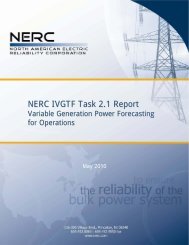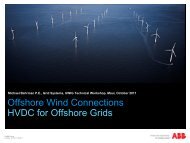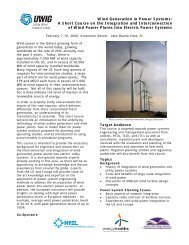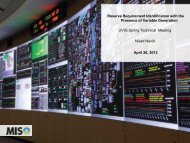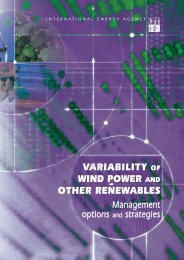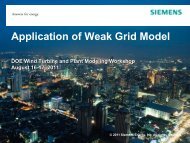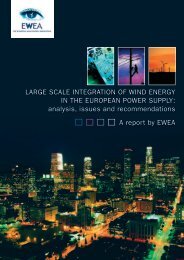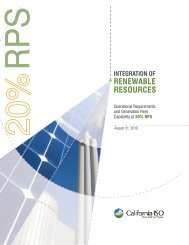Integrating Southwest Power Pool Wind to Southeast Electricity ...
Integrating Southwest Power Pool Wind to Southeast Electricity ...
Integrating Southwest Power Pool Wind to Southeast Electricity ...
Create successful ePaper yourself
Turn your PDF publications into a flip-book with our unique Google optimized e-Paper software.
5<br />
HIGH WIND TRANSFER CASE RESULTS<br />
This chapter examines results from the High <strong>Wind</strong> Transfer scenarios described in the previous<br />
chapters. As noted in Chapter 2, all of the high wind transfer cases utilize the Transportation<br />
mode solution that provides an unconstrained transmission network model so that transmission<br />
does not curtail wind significantly. Utilizing these models, first, the impact of increasing SPP<br />
wind generation capacity from 14 GW <strong>to</strong> 48 GW is examined briefly <strong>to</strong> provide context as <strong>to</strong> the<br />
effect of high levels of wind on the unconstrained case so that the subsequent results are better<br />
unders<strong>to</strong>od. The bulk of the chapter examines in detail the differences in the four High <strong>Wind</strong><br />
Transfer scenarios that are the basis for understanding the potential benefits of coordinated<br />
scheduling and balancing throughout the SPP-SERC footprint. Generation, interchanges between<br />
regions, costs, and reserve allocation are shown <strong>to</strong> better understand the possible benefits of<br />
cooperation.<br />
Impacts of Increasing <strong>Wind</strong> Penetration <strong>to</strong> Meet 20% RES<br />
This subsection examines how generation output and flows across the SPP-SERC footprint are<br />
impacted when wind generation capacity in SPP increases from the 14 GW level <strong>to</strong> 48 GW.<br />
Identifying these impacts is not the primary focus of the study, but understanding the change in<br />
generation which is due <strong>to</strong> high wind being added provides a better understanding of how the<br />
generation and flows between regions will change as the wind is being balanced differently,<br />
which is examined in the next section. The analysis is based on comparison of the 14 GW<br />
“unconstrained” case described in Chapter 2 and the High <strong>Wind</strong> Transfer Scenario #1 described<br />
in Chapter 4. Table 5-1 lists the only differences in the case setups, with all other aspects of the<br />
cases being the same.<br />
Table 5-1<br />
Differences in 14 GW Unconstrained and High <strong>Wind</strong> Scenario #1 Case Setups<br />
14 GW Unconstrained High <strong>Wind</strong> Scenario #1<br />
Installed <strong>Wind</strong> Cap 14 GW 48 GW<br />
Scheduling of DA <strong>Wind</strong> Forecast All <strong>to</strong> SPP Shares <strong>to</strong> SPP and SERC<br />
Intra-Hr Reserves for <strong>Wind</strong><br />
Carried by SPP alone for<br />
14 GW<br />
5-1<br />
Carried by SPP alone for<br />
all 48 GW<br />
Generation and Interchange Differences<br />
Increasing installed wind capacity by 34 GW within the footprint obviously impacts the output<br />
levels of other types of generation within each region and the flows between regions. Table 5-2<br />
shows the change in average generation when wind is increased from 14 GW installed capacity<br />
<strong>to</strong> 48 GW. As expected, wind displaces combined cycle gas (CC) and coal usage. Blue indicates<br />
a reduction in generation, green an increase, as wind is added <strong>to</strong> the system. There is a small




